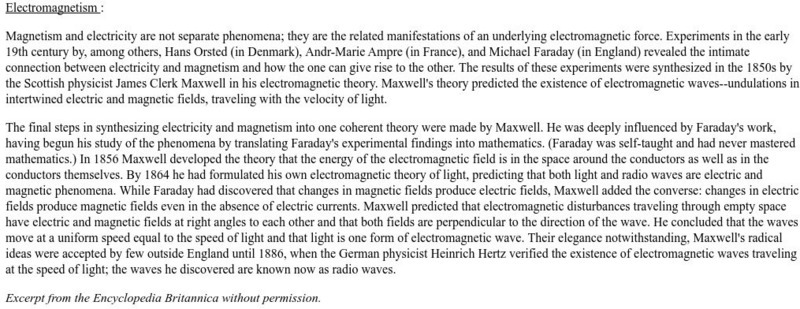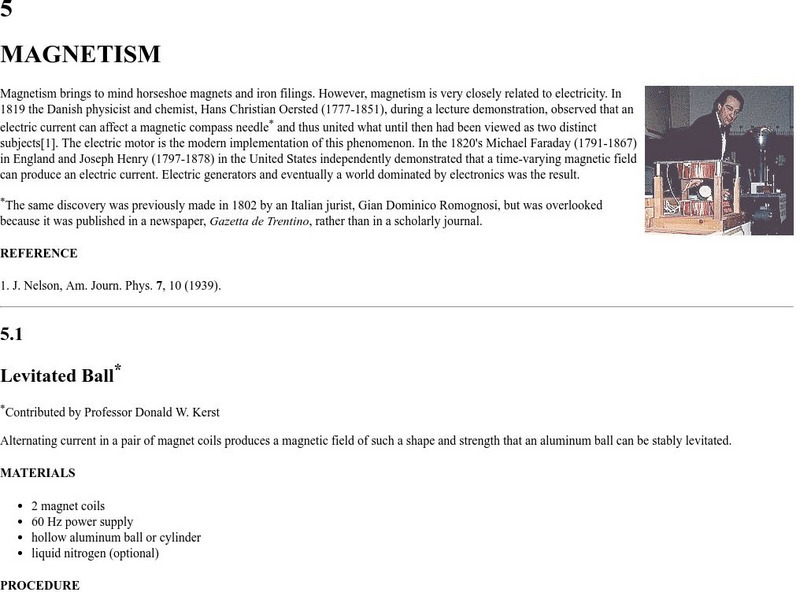Science and Mathematics Initiative for Learning Enhancement (SMILE)
Smile: Electromagnets (Grades 3 and 4)
This lesson helps students to understand the difference between magenets and electromagnets. They will also create an electromagnet.
Wikimedia
Wikipedia: Andre Marie Ampere
This site from the encyclopedia Wikipedia provides a nice overview of the life of Andre Marie Ampere. Content covered includes an overview of his upbringing, his time as professor, and his study of electromagnetism.
Wikimedia
Wikipedia: James Clerk Maxwell
Examine the life and contributions of James Clerk Maxwell. This site also provides links to explanations of many of Maxwell's contributions in the field of physics.
Other
Hyper Jeff Network: History of Classic Electromagnetism
This site from the HyperJeff Network provides a timelined history of scientific thought and discoveries about classic electromagnetism. Includes links to the biographies of famous people and discoverers; the time period covered ranges...
University of Oregon
University of Oregon: Electromagnetism
A solid summary from the University of Oregon of the work of James Maxwell Clerk, Michael Faraday, and others in the field of electric and magnetic phenomena. This is a fine essay.
Concord Consortium
The Concord Consortium: Molecular Workbench: Lorentz Force 3 D
Adjust the magnetic field intensity and the particle speed in this simulation to observe the affect the movement of the particle.
Concord Consortium
The Concord Consortium: Molecular Workbench: The Hall Effect
Adjust the magnetic field in this simulation to see how the flow of electricity is affected.
Sophia Learning
Sophia: Electromagnetism
This lesson will explain the relationship between electricity and magnetism.
National High Magnetic Field Laboratory
Magnet Academy: Davenport Motor 1834
Odd though it seems today, when Thomas Davenport was selling one of the first electric motors way back in the 1830s, nobody was buying.
Ducksters
Ducksters: Physics for Kids: Electromagnetism and Electric Motors
Kids learn about electromagnetism and electric motors in the science of electricity and physics including the right-hand rule, generation, and induction.
Cornell University
Cornell University: Astronomy: Electromagnetism and Charge
This site from Cornell University provides a very short, very telling comparison of matter and charge. This is a good site to check out on the subject, with a chart diagram to help with further information.
Other
Fermilab: What Are the Basic Forces Between Particles?
Get an introduction to the four forces that interact between atomic particles. With the help of a simulation you'll see how building reconstruction would be affected without each of the forces.
University of Wisconsin
University of Wisconsin: 5 Magnetism
From an online teacher demonstration book. Includes a description and explanation of five demonstrations on a variety of magnetism topics. Interesting and captivating demos.
Lawrence Berkeley National Laboratory
Berkeley Lab: Four Fundamental Interactions
Discussion of the four fundamental forces of nature: strong interactions, weak interactions, gravity, and electromagnetism.
Science4Fun
Science4 Fun: How Electricity Is Made
Read this brief article to gain an understanding of the principle of electromagnetism, how electricity is generated, and the problem with fossil fuels.
Mocomi & Anibrain Digital Technologies
Mocomi: What Is Electromagnetism?
Explains electromagnetism, the difference between a permanent magnet and an electromagnet, uses of electromagnetism, and steps for making a simple electromagnet.
Science and Mathematics Initiative for Learning Enhancement (SMILE)
Smile: Introduction to Magnets (Classroom Unit)
A teacher unit which includes several hands-on activities about types of magnets, magnetism, and electrostatics. An activity designed to suit all grade levels. Many parts of the activity would be easily adaptable as a student project.

















